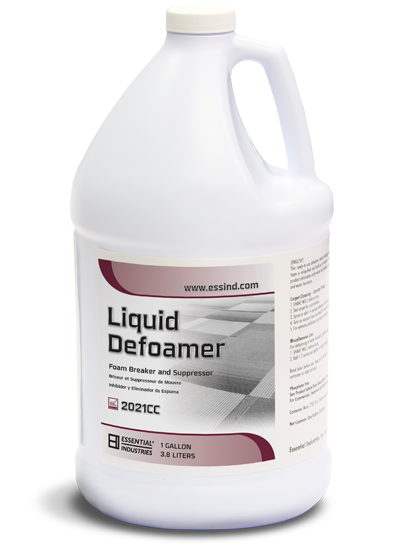Best Practices and Proven Ways for Using Chemical Defoamer in Different Processes
Wiki Article
The Importance of Using a Chemical Defoamer in Numerous Applications
The application of chemical defoamers is an important consideration across several sectors, consisting of food processing, wastewater treatment, and drugs. These agents play an essential duty in mitigating foam development, which can impede effectiveness and concession product top quality.Comprehending Foam Development
Foam formation is a complex physical phenomenon that happens when gas bubbles are entraped within a fluid matrix, causing the development of a steady structure. This procedure can be influenced by different elements, consisting of the thickness of the liquid, the surface area stress at the gas-liquid user interface, and the existence of surfactants. Surfactants reduced the surface tension, promoting bubble creation and stablizing, which typically leads to the development of foam in numerous commercial processes.Foams are generally come across in applications such as food production, wastewater therapy, and chemical production. In these contexts, foam can work as an insulator, interfere with blending processes, or impede the efficiency of tools. The security of foam is identified by the equilibrium between the pressures acting to support the bubbles and those that advertise their collapse.
Understanding the auto mechanics of foam development is important for properly handling its visibility in various systems. By understanding the underlying concepts, industries can create techniques to alleviate undesirable foaming, consequently enhancing functional effectiveness and item high quality. This fundamental expertise functions as a precursor to discovering the utility of chemical defoamers, which specifically attend to foam-related obstacles in numerous applications.
Advantages of Chemical Defoamers
Chemical defoamers provide substantial benefits throughout numerous industries by properly managing and reducing foam development. Among the primary advantages is improved functional efficiency. By minimizing foam, chemical defoamers assist preserve ideal production rates and lower downtime connected with foam monitoring. This is particularly critical in processes where extreme foam can impede equipment or disrupt workflows.Furthermore, chemical defoamers add to enhanced item top quality. Foaming commonly causes disparities in formulations, which can detrimentally affect the end product. By managing foam degrees, defoamers make certain uniformity, thus enhancing the general high quality of the result.
Cost-effectiveness is an additional remarkable advantage (Chemical Defoamer). By decreasing the amount of basic materials required for manufacturing and reducing waste, chemical defoamers can result in significant savings. Moreover, they usually permit for decreased energy usage, as procedures can run extra efficiently and need less treatment.
Applications in Food Processing
In the food handling industry, efficient management of foam is essential to make certain both item quality and functional efficiency. Foam can hinder various procedures, from mixing and mixing to packaging, causing reduced returns and potential contamination. Chemical defoamers play an important role in mitigating these problems by promptly breaking down foam, permitting for smoother operations and enhanced item uniformity.In applications such as dairy processing, defoamers prevent excess foam development during the production of cheese, milk, and yogurt, which can disrupt that site equipment and affect the structure of the end product. In developing and fermentation processes, foam control is crucial to keep the stability of the beverage and make sure optimum fermentation rates.
Additionally, chemical defoamers are made use of in food dressings, solutions, and sauces to improve the security and look of the final products. By reducing foam throughout manufacturing, suppliers can attain better mixing and dispersion of components, causing premium quality. In general, the consolidation of chemical defoamers in food processing is essential for keeping performance, top quality, and safety and security in food manufacturing.
Duty in Wastewater Treatment
Reliable foam administration is similarly crucial in wastewater therapy procedures, where extreme foam can prevent procedures and make complex the therapy of effluents. In several wastewater therapy facilities, foam can develop as a result of biological activity, surfactants, or various other natural materials present in the influent. This foam can result in a series of operational challenges, consisting of decreased therapy efficiency, boosted upkeep demands, and possible governing conformity problems.Chemical defoamers play a vital role in reducing these challenges. By reducing the surface area tension of the liquid, defoamers advertise the collapse of foam frameworks, therefore helping with smoother operation of tools such as oygenation storage tanks and clarifiers. Their timely application helps keep ideal hydraulic conditions, boosting the general effectiveness of solids splitting up processes.

Influence On Pharmaceutical Production
Foam control is crucial in pharmaceutical manufacturing, where the visibility of too much foam can interfere with making procedures and concession item quality (Chemical Defoamer). The formation of foam during various phases, such as blending, mixing, and fermentation, can lead to inefficient blending, poor warmth transfer, and also devices damage. These problems not just result in operational hold-ups but can also cause substantial financial losses and influence conformity with rigid regulative requirementsChemical defoamers are especially created to minimize these difficulties. By efficiently decreasing foam formation, they boost procedure performance and preserve the integrity of the final item. Specifically, defoamers make certain consistent dose types, improve the security of suspensions and emulsions, and streamline cleaning processes by protecting against foam accumulation in devices.
In addition, using defoamers can optimize the return of active pharmaceutical ingredients (APIs) by promoting better removal and purification procedures. As pharmaceutical business strive to boost item high quality while minimizing manufacturing costs, the duty of chemical defoamers becomes increasingly important - Chemical Defoamer. Their unification into making procedures not just sustains compliance with Excellent Manufacturing Practices (GMP) yet likewise cultivates technology and competition in a rapidly progressing industry

Conclusion

Chemical defoamers offer substantial advantages throughout different sectors by effectively that site controlling and minimizing foam formation. By lessening foam, chemical defoamers aid maintain optimum production prices and decrease downtime linked with foam management. Chemical defoamers play a vital role in alleviating these issues by quickly breaking down foam, allowing for smoother operations and boosted product uniformity.
Reliable foam management is similarly vital in wastewater therapy procedures, where excessive foam can impede operations and complicate the treatment of effluents.Foam control is vital in pharmaceutical production, where the existence of too much foam can disrupt producing procedures and concession item high quality.
Report this wiki page